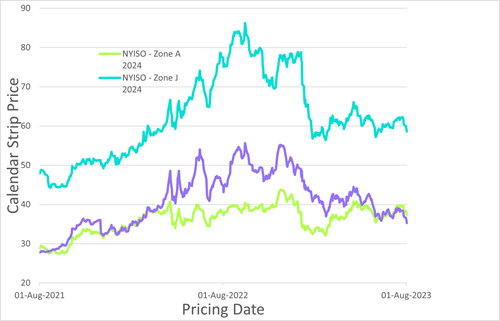Smartest Insight | Issue 129

Our weekly company round-up covers the key market and industry news in one place, so you don’t have to look any further to stay ahead.
August 04, 2023
Market Update:
Natural Gas Storage was reported at +14 BCF for the week ending 7/28/23. This was 22% of the last year and 12% above the 5-yr average. Prompt month gas is up 3.27% to $2.56 as the 8-14 day forecast calls for above normal chance of heat in for southern and western half of country.
Last week, PJM, NYISO, NEISO was under an excessive heat warning on July 27th and 28th. Real time prices spiked during certain hours on those two days to over $120/MWh but did little to impact the monthly average that ranged between $30-$45/MWh.
In general, this summer has not seen extended heat warner in most of the city centers in the U.S. This is despite the extreme heat being felt throughout the month of July. With relatively normal temperatures, ample storage and production that continues to put out +100 BCF per day, prices for the month have been relatively moderate. Currently, there is no major hurricanes in the horizon.
For these reasons, the system gives the appearance of being in good shape until next winter.
In NY liquidity for zone J capacity has dried up on the wholesale market pushing prices up considerably. Our view is that this could be a short term spike with some relieve to come in a few months. Please reach out to your Smartest representative to create a custom strategy to suit your needs.

Regulatory Report:
FERC issues Final Rule, Order 2023 to address backlog
The US Federal Energy Regulatory Commission (FERC) issued a final rule (Order 2023) to address the backlog of clean energy projects seeking to interconnect to the US power grid. The rule prioritizes projects closer to commercial operation and aims to remove speculative ones from congested queues. Currently, over 2,000 GW of projects wait in queues, causing up to five years of delays. Lawrence Berkeley National Laboratory found that high transmission upgrade costs lead renewable developers to drop out, contributing to nearly four-year wait times for successful projects.
To tackle these challenges, FERC's final rule increases financial commitments for interconnection customers, including higher study deposits and stricter site control requirements. Project developers can also expect to face penalties if they withdraw their requests from the interconnection queue. Clean energy groups are in support of the rule, stating deadlines and penalties will help alleviate backlog in projects.
FERC Chairman Willie Phillips said the rule is historic, ensuring reliable, efficient, transparent, and timely interconnection of the country's generation resources. It's one of FERC's largest rules and represents significant interconnection reforms since the pro forma procedures two decades ago, addressing hurdles in the US clean energy transition.
Offshore Wind for Maine
Maine Governor Janet Mills signed legislation on July 27, setting a target of up to 3,000 MW of installed offshore wind capacity in federal waters by 2040. The bill establishes the Maine Offshore Wind Renewable Energy and Economic Development Program to organize competitive solicitations, stabilize energy prices, reduce reliance on imported fossil fuels, and achieve the state's wind energy generation goal. The first request for proposals will be issued by January 15, 2026, and contracts must be cost-effective for ratepayers. The state aims to leverage its maritime industry to develop a purpose-built offshore wind port. Maine plans to source 80% of its electricity from renewables by 2030 and achieve a fully decarbonized power grid by 2040.
NY Zone J Capacity Update:
Maine Governor Janet Mills signed legislation on July 27, setting a target of up to 3,000 MW of installed offshore wind capacity in federal waters by 2040. The bill establishes the Maine Offshore Wind Renewable Energy and Economic Development Program to organize competitive solicitations, stabilize energy prices, reduce reliance on imported fossil fuels, and achieve the state's wind energy generation goal. The first request for proposals will be issued by January 15, 2026, and contracts must be cost-effective for ratepayers. The state aims to leverage its maritime industry to develop a purpose-built offshore wind port. Maine plans to source 80% of its electricity from renewables by 2030 and achieve a fully decarbonized power grid by 2040.
